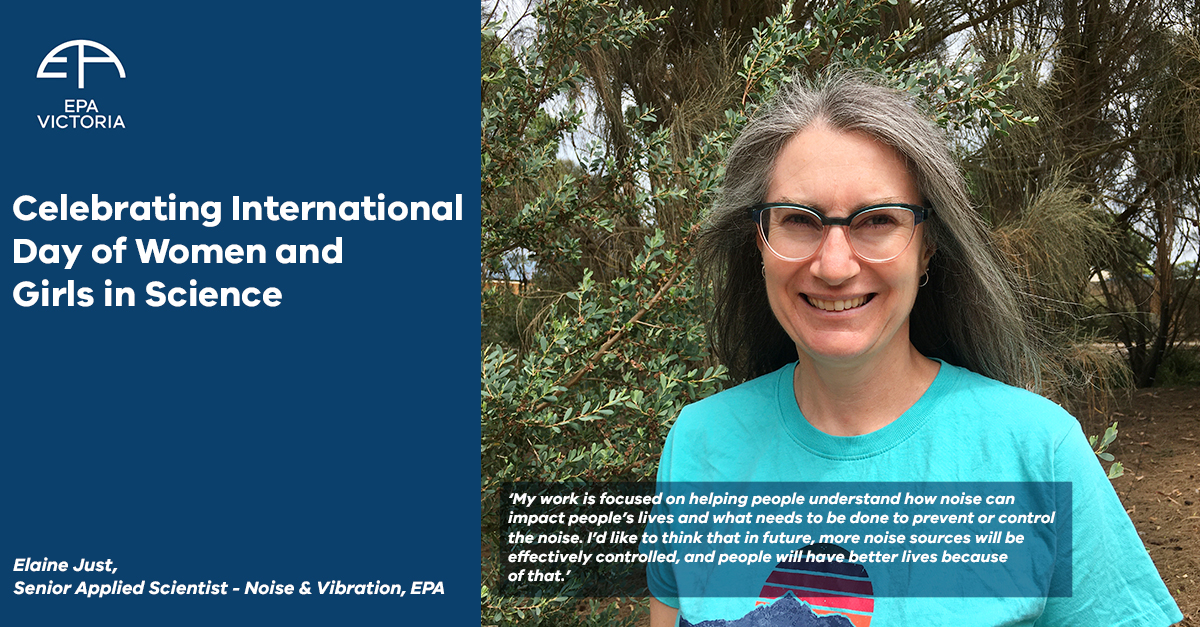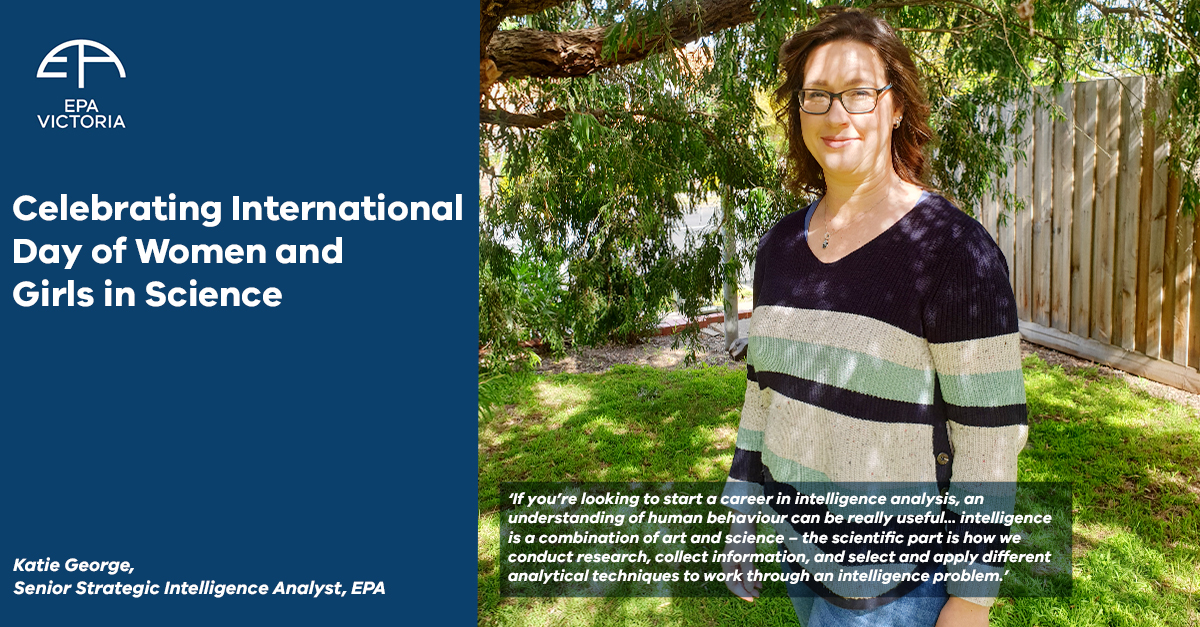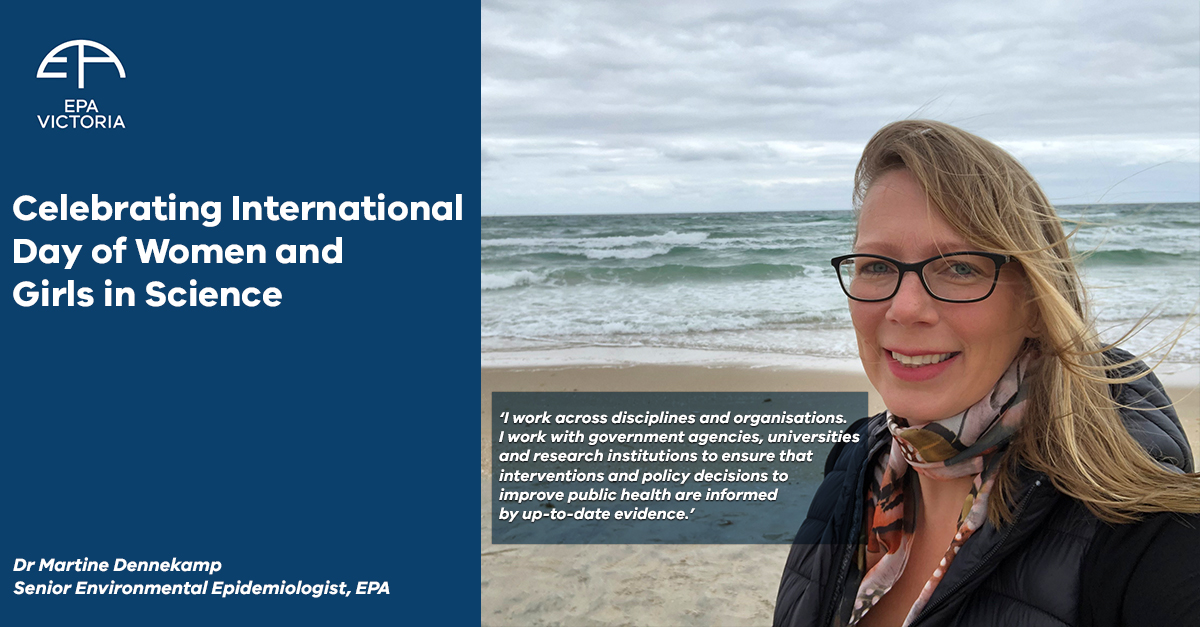To celebrate the International Day of Women and Girls in Science 2021 on 11 February, we are profiling three of our scientists.
In these short interviews, you'll find out about the role and work, motivations and interests of Senior Applied Scientist – Noise and Vibration Elaine Just; Senior Intelligence Analyst Katie George; and Senior Epidemiologist Environmental Public Health Dr Martine Dennekamp.
Elaine Just, Senior Applied Scientist – Noise & Vibration

How long have you worked at EPA?
I've worked at EPA for 20 years in various roles including as an environment protection officer, in policy and regulation and I'm now a Senior Applied Scientist – Noise & Vibration.
What is a typical day in your role?
Currently I'm helping the organisation prepare for the new laws that are intended to come into effect on 1 July, 2021. My typical day includes writing guidance and web pages to help industry, community and other duty holders understand and apply the new laws and manage their impact on the environment. I'm also advising on a new geographic information system (GIS) application for our environment protection officers to calculate industry noise limits.
I respond to queries from the community and review my colleagues' work on assessing noise risks from proposed developments. And there are lots of meetings and chats to co-ordinate noise-related work across EPA.
How is your work making a difference in Victoria?
My work is focused on helping people understand how noise can impact upon people's lives and what needs to be done to prevent or control the noise. I'd like to think that in future, more noise sources will be effectively controlled, and people will have better lives because of that.
What is some advice you'd pass on to someone who is interested in this career path?
You'll need to understand the finer details, but focus on the big picture view as to why it's important. Also, its rewarding to work with people who are committed to protecting and improving the environment and people's health.
What are you watching, reading or listening to?
I'm reading Beatrix Potter: a life in nature and listening to the science updates on coronavirus (COVID-19) on ABC Radio's Coronacast podcast.
Katie George, Senior Strategic Intelligence Analyst

What is your role in EPA's Intelligence and Data Analytics team?
I am a Senior Intelligence Analyst. The role involves producing assessments based on insights drawn from different disparate pieces of information in various forms. I help to connect the dots about what might happen, or be happening, to reduce uncertainty for people deciding on a course of action. I also help lead our team - mentoring and providing advice and support to other analysts to produce and communicate their assessments.
How long have you worked at EPA?
I have been with EPA since August 2019. I have worked in the intelligence sector for 10 years and started out as a junior tactical analyst in 2011 with a federal government agency.
What does a typical day look like in your role?
Much of my role is focused on building networks and relationships with decision makers by planning how our analysts can support their efforts.
I also spend time demonstrating how intelligence can help people make more informed decisions. Most days, I start out by reviewing requests for intelligence with my team leader and scope these out. An analyst and I then plan together how to fulfill the request. Sometimes we work on developing analytical skills or a specific technique. As a Senior Intelligence Analyst, I also review assessments produced by others and provide guidance about how to resolve intelligence gaps.
Intelligence is a combination of art and science – the scientific part is how we conduct research, collect information, and select and apply different analytical techniques to work through an intelligence problem.
How is your work making a difference in Victoria?
A major focus at EPA is strengthening our intelligence function as part of our work to become a world class insights-based regulator. My work supports this uplift. Our team's assessments help to build organisational knowledge on trends and issues. Our assessments support our colleagues to understand where to focus operational resources to plan how to respond.
What advice would you offer someone who is interested in this career path?
If you're looking to start a career in intelligence analysis, an understanding of human behaviour is really useful. Work on your research skills and develop good discipline around aggressive information collection – that is, be very selective in terms of what you collect, when and why. You should also watch out for logic traps and cognitive bias (these are easy to spot in others' thinking, but not so much in your own).
What are you watching, reading or listening to?
Thinking, fast and slow by Daniel Kahneman; which explains the two systems of why we think the way we do.
Dr Martine Dennekamp, Senior Environmental Epidemiologist, Environmental Public Health

What is your role at EPA?
As an environmental epidemiologist at EPA, my ultimate goal is to reduce and prevent harm to human health from pollution and waste.
Environmental epidemiologists like myself focus on the complex relationship between human health and environmental factors. So, I work across disciplines and organisations, collaborating with other government agencies, universities and research institutions to ensure that interventions and policy decisions to improve public health are informed by up-to-date evidence.
How long have you worked at EPA?
I have been with EPA for three years. Prior to that, I mainly worked in academia; one year as a researcher at a medical school in Ireland, and before that, 12 years at Monash University as an air pollution epidemiologist.
What does a typical day look like in your role?
No day is the same which makes my job very interesting.
I provide advice on risks to environmental public health as it relates to EPA's role, both internally and externally. I lead the development of environmental public health projects to address gaps in knowledge in Victoria, and provide the information needed to develop evidence-based policies. EPA's Environmental Public Health Unit is also developing an environmental health tracking network (EHTN) that will display up-to-date evidence-based information on the impacts of pollution and waste on public health. The EHTN will provide the public and other stakeholders with customised maps, tables, and charts of local and state-wide public health and environmental information.
I generally work in the surveillance and prevention space, and also provide advice during emergencies such as smoke events.
How is your work making a difference in Victoria?
My work provides the information needed to enable evidence-based decision making, guidance and policy. I am currently the Chair of a national working group tasked with developing evidence-based nationally consistent air quality categories and messaging in line with the recent recommendation from the Royal Commission into National Natural Disaster Arrangements. These have now been nationally endorsed and implemented in Victoria and will be implemented by all jurisdictions across Australia ahead of the next fire season.
What advice would you offer someone interested in this career path?
Do it! It's very rewarding. Always be guided by the evidence. Share knowledge, take a collaborative approach, and think holistically. Don't underestimate yourself and go for it!
What are you watching, reading or listening to?
I love reading biographies, but I have just started reading The loudness of unsaid things by Hilde Hinton.
You will find me on the beach most days – no matter what the weather is.






